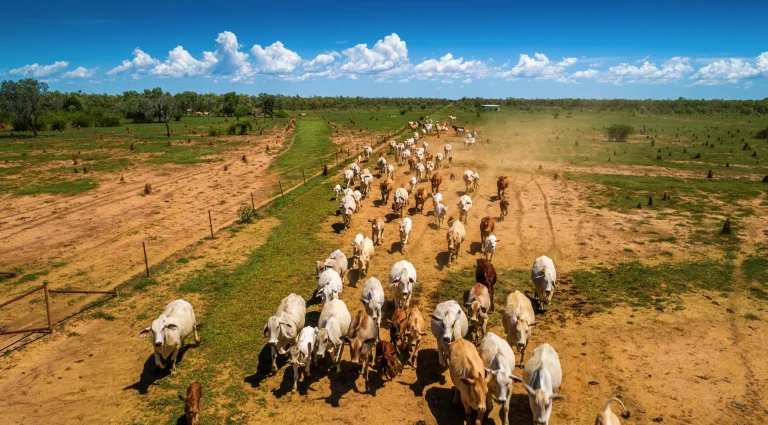Calculating Investment Returns for Grazing Land Ventures: A Complete Guide
Successful grazing land investments require careful financial analysis to ensure sustainable returns in today’s competitive agricultural market. When calculating investment returns for grazing land ventures, investors must consider multiple factors including land appreciation, carrying capacity, operational costs, and market conditions. At Agribusiness Horizons, we help clients navigate these complex calculations to make informed decisions about their pastoral investments. Whether you’re considering your first grazing property or expanding an existing portfolio, understanding the fundamentals of return calculations will guide you toward profitable ventures.
Understanding the Grazing Land Investment Landscape
The pastoral industry has experienced significant transformation over recent decades, with institutional investors and family offices increasingly recognizing grazing land as a valuable asset class. Modern grazing operations combine traditional livestock management with sophisticated business practices, creating opportunities for investors who understand both the agricultural and financial aspects of these ventures.
Grazing land investments offer unique advantages compared to other agricultural sectors. These properties typically provide stable cash flows through livestock sales, wool production, or agistment arrangements, while also offering potential for capital appreciation. The extensive nature of grazing operations means that investors can acquire substantial land holdings, often in regions with favorable climate conditions and established infrastructure.
Climate variability remains a defining characteristic of Australian grazing regions, making drought resilience and water security crucial factors in investment decisions. Properties with reliable water sources, diverse pasture systems, and proven management practices tend to deliver more consistent returns over time. Understanding these regional dynamics is essential when calculating investment returns for grazing land ventures.
Key Financial Metrics for Grazing Land Analysis
Return on Investment Fundamentals
The foundation of any grazing land investment analysis begins with understanding the primary return drivers. Capital appreciation represents one component, typically driven by land scarcity, infrastructure improvements, and regional development trends. However, operational returns from livestock production, agistment income, and value-added enterprises often provide the consistent cash flows that make these investments attractive.
Calculating gross returns requires accurate assessment of carrying capacity under different seasonal conditions. This involves analyzing historical stocking rates, pasture productivity, and livestock performance data. Professional agronomic assessment helps determine sustainable stocking rates that maintain land condition while maximizing productivity.
Net returns depend heavily on operational efficiency and cost management. Successful grazing operations typically achieve economies of scale through strategic property sizing, efficient infrastructure utilization, and optimized labor management. These factors directly impact the financial performance metrics that investors use to evaluate potential acquisitions.
Cash Flow Analysis Methods
Developing comprehensive cash flow projections for grazing land ventures requires understanding both the cyclical nature of livestock markets and the seasonal patterns of pastoral operations. Annual cash flows typically include income from livestock sales, wool production where applicable, and any agistment or lease arrangements.
Operational expenses encompass feed costs, veterinary services, labor, maintenance, rates, and insurance. Variable costs fluctuate with seasonal conditions and market cycles, while fixed costs remain relatively stable regardless of production levels. Accurate expense forecasting requires detailed knowledge of local operating conditions and industry benchmarks.
Working capital requirements in grazing operations can be substantial, particularly during drought periods or market downturns. Investors must account for the capital needed to maintain livestock numbers, fund feed purchases, and sustain operations through challenging periods. This working capital component significantly impacts overall return calculations.
Valuation Approaches for Grazing Properties
Comparable Sales Analysis
Market-based valuation relies on analyzing recent sales of similar grazing properties in comparable regions. This approach considers factors such as carrying capacity, water security, infrastructure quality, and regional rainfall patterns. However, the heterogeneous nature of grazing properties means that direct comparisons require careful adjustment for differences in property characteristics.
Recent market activity in premium grazing regions reflects strong demand from both domestic and international investors. Properties with superior water security, established infrastructure, and proven management systems command premium pricing. Understanding these market dynamics helps investors identify opportunities where purchase prices may offer attractive return potential.
Location factors significantly influence grazing land values, with proximity to processing facilities, transport infrastructure, and regional centers affecting both operational efficiency and property values. Properties in established grazing regions with reliable rainfall and good soil types typically maintain stronger value stability through market cycles.
Income Capitalization Method
The income approach to grazing land valuation focuses on the property’s capacity to generate sustainable returns over time. This method requires detailed analysis of long-term carrying capacity, livestock productivity, and operational efficiency. Professional agronomic assessment provides the foundation for accurate income projections.
Capitalization rates for grazing land investments vary based on property quality, location, and market conditions. Premium properties with superior water security and infrastructure typically trade at lower capitalization rates, reflecting their lower risk profile and greater investor demand. Understanding these rate variations helps investors identify value opportunities in the market.
Risk assessment plays a crucial role in income-based valuations, with factors such as drought exposure, market volatility, and operational complexity affecting the appropriate discount rates. Properties with diversified income streams and proven drought resilience typically warrant lower risk premiums in valuation calculations.
Comparison of Grazing Land Investment Strategies
| Investment Strategy | Capital Requirements | Risk Profile | Return Potential | Management Intensity |
|---|---|---|---|---|
| Passive Ownership | Moderate to High | Lower | Steady appreciation | Minimal |
| Active Operations | High | Moderate | Higher cash yields | Intensive |
| Agistment Focus | Moderate | Lower | Stable income | Moderate |
| Value-Adding | Very High | Higher | Premium returns | Very intensive |
Risk Factors and Mitigation Strategies
Climate and Seasonal Risks
Drought risk represents the most significant challenge for grazing land investments, with extended dry periods capable of severely impacting both operational returns and property values. Successful investors develop comprehensive drought management strategies that include destocking protocols, feed budgeting, and financial reserves to maintain operations through difficult periods.
Water security assessment forms a critical component of risk evaluation, with properties offering multiple water sources and storage capacity providing greater operational flexibility. Modern water infrastructure, including solar pumping systems and efficient distribution networks, can significantly enhance drought resilience and operational efficiency.
Pasture management practices directly influence both productivity and risk exposure. Properties with diverse pasture species, rotational grazing systems, and soil conservation measures typically demonstrate greater resilience to climatic variability. These management practices also contribute to long-term land condition improvement and value enhancement.
Market and Operational Risks
Livestock market volatility affects both operational returns and exit strategies for grazing land investors. Diversification across different livestock classes, market timing strategies, and forward selling arrangements can help mitigate price risk. Understanding market cycles and developing flexible marketing strategies enhances return stability.
Operational risks include labor availability, equipment reliability, and biosecurity challenges. Remote locations and specialized skill requirements can create labor management challenges that impact operational efficiency. Developing strong relationships with local contractors and service providers helps mitigate these operational risks.
Regulatory changes affecting land use, water rights, and environmental compliance can significantly impact grazing operations. Staying informed about policy developments and maintaining compliance with environmental regulations protects both operational continuity and property values.
Agribusiness Horizons’ Approach to Grazing Land Investments
Our team at Agribusiness Horizons brings specialized expertise to calculating investment returns for grazing land ventures, combining deep agricultural knowledge with sophisticated financial analysis. We understand that successful grazing land investments require more than simple yield calculations – they demand comprehensive understanding of regional conditions, market dynamics, and operational requirements.
Our valuation methodology incorporates multiple approaches to provide clients with accurate assessments of investment potential. We analyze comparable sales data, develop detailed cash flow projections, and conduct thorough risk assessments to ensure our clients make informed decisions. Our extensive network of agricultural professionals, including agronomists, veterinarians, and livestock specialists, provides the technical expertise needed for comprehensive property evaluation.
We also provide ongoing support throughout the investment lifecycle, from initial acquisition through to eventual disposal. Our market timing analysis helps clients optimize entry and exit strategies, while our operational advisory services assist with management decisions that impact financial performance. This comprehensive approach ensures that our clients achieve their investment objectives while managing the inherent risks of grazing land ownership.
Technology and Data Analytics in Return Calculations
Modern grazing land investment analysis increasingly relies on sophisticated data analytics and technology platforms. Satellite imagery, weather data, and soil mapping provide detailed insights into property productivity and risk factors. These technological tools enable more accurate carrying capacity assessments and improved drought risk modeling.
Financial modeling software specifically designed for agricultural investments helps investors develop comprehensive return projections that account for seasonal variability and market cycles. These tools enable scenario analysis that tests investment performance under different climate and market conditions, providing valuable insights for decision-making.
Blockchain technology and digital platforms are beginning to transform livestock tracking and market transparency, potentially creating new opportunities for operational efficiency and market access. Forward-thinking investors are beginning to incorporate these technological trends into their investment strategies and return calculations.
Conclusion
Understanding the complexities of calculating investment returns for grazing land ventures requires both financial expertise and deep agricultural knowledge. Successful investors recognize that these calculations must account for multiple variables including land appreciation, operational returns, climate risks, and market dynamics. The extensive nature of grazing operations, combined with their exposure to seasonal variability, creates unique challenges that require sophisticated analytical approaches.
As you consider your grazing land investment strategy, several questions deserve careful consideration: How will climate change affect long-term productivity and risk profiles in your target regions? What role will technological advancement play in improving operational efficiency and return potential? How might changing consumer preferences and global trade patterns influence future market conditions for Australian pastoral products?
The grazing land investment landscape continues to offer compelling opportunities for investors who approach these ventures with appropriate expertise and comprehensive analysis. At Agribusiness Horizons, we’re committed to helping our clients navigate these complex investment decisions with confidence. Contact us today to discuss how our specialized knowledge and analytical capabilities can support your grazing land investment objectives. Our team is ready to provide the expert guidance you need to achieve successful outcomes in this dynamic and rewarding sector.



